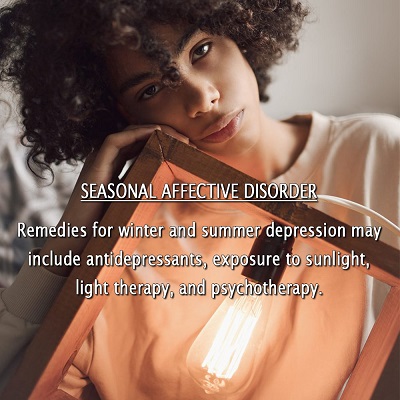 During the colder months, it’s easy to feel down and miserable because of the necessity to stay indoors. This feeling can persist for weeks or months, and unfortunately, many people can’t help feeling the winter blues. Why is that?
During the colder months, it’s easy to feel down and miserable because of the necessity to stay indoors. This feeling can persist for weeks or months, and unfortunately, many people can’t help feeling the winter blues. Why is that?
Seasonal affective disorder is recognizable because it is experienced mostly during the winter months, due to shorter days and less sunlight.
Seasonal affective disorder (SAD), also called seasonal depression, can affect anybody during the same season every year. There are two types of this disorder. The fall onset of SAD is called the winter depression. It arises during late fall and lasts through the winter months. While the spring onset is a rare case of SAD called summer depression. It can happen from late spring until early summer.
SAD Symptoms
If you feel you may be someone who experiences SAD, there are symptoms you can look out for. You may have negative displays of emotion such as being sad or down most days, cranky, listless, and anxious. You may isolate yourself from family and friends and lose interest in social activities.
Less daylight may make you oversleep and feel lethargic during the day. You have decreased productivity because you find it hard to wake up early in the morning and stay alert during the daytime. You lack mental clarity and are unable to focus and concentrate on your tasks. Because you easily feel tired, you also may develop low energy levels.
You may develop cravings for starchy foods and sweet treats. If your appetite increases, it may cause overeating and unwanted weight gain.
People who develop winter SAD recover quickly in about a week or so when spring finally comes around.
Causes of Seasonal Affective Disorder
The exact cause of this disorder is unknown, however, it is believed that hormonal irregularities in the brain caused by changes in the season trigger seasonal affective disorder. These hormonal changes cause corresponding attitude-related changes.
Since the days are longer during summer, and you wake earlier and go to bed later, and there is less sunlight during winter, which makes you sleep longer, your internal body clock is disrupted. This biological clock regulates our hormones, mood, and sleep. When it shifts because of the changes in seasons, you have difficulty adjusting to daylight length. Therefore, feeling down is experienced.
Here are some more of the common causes of SAD:
Melatonin Overload
Darkness or lack of sunlight during fall and winter may induce the body to overproduce melatonin. It is the hormone that signals your body to sleep. So, doing your usual activities is hard because you always feel sleepy and lethargic.
Reduced Serotonin Levels
Less sunlight causes serotonin levels to drop. These are the brain chemicals our nerve cells produce and contribute to feelings of happiness. This brain chemical imbalance can affect mood and result in feelings of lethargy, depression, and other symptoms.
Insufficient Vitamin D
Vitamin D is known as the sunlight vitamin. So we benefit more from Vitamin D when there is plenty of sunlight. If your skin is exposed more to sunlight, it helps boost your serotonin activity, which is your defense against depression. However, people typically become deficient in vitamin D during winter. A lack of this vitamin from foods and supplements can trigger stress, anxiety, or depression in some people.
Final Thoughts
People experiencing seasonal affective disorder (SAD) should not ignore the symptoms mentioned above because it can worsen just like any other type of depression or anxiety disorder. It can lead to work or school problems, substance abuse, social withdrawal, and negative thoughts and behaviors.
You can stop your symptoms from getting worse by managing the symptoms from their onset. Remedies for winter and summer depression may include antidepressants, exposure to sunlight, light therapy, and psychotherapy. It’s best to talk to your healthcare provider so they can help you or the people you care about who are suffering from SAD.





